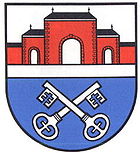Heiningen (Lower Saxony)
| coat of arms | Germany map | |
|---|---|---|

|
Coordinates: 52 ° 4 ′ N , 10 ° 33 ′ E |
|
| Basic data | ||
| State : | Lower Saxony | |
| County : | Wolfenbüttel | |
| Joint municipality : | Oderwald | |
| Height : | 101 m above sea level NHN | |
| Area : | 8.41 km 2 | |
| Residents: | 652 (Dec. 31, 2019) | |
| Population density : | 78 inhabitants per km 2 | |
| Postal code : | 38312 | |
| Area code : | 05334 | |
| License plate : | WF | |
| Community key : | 03 1 58 019 | |
| Association administration address: | Bahnhofstrasse 6 38312 Börßum |
|
| Mayor : | Marc Mechsner (WsH) | |
| Location of the community of Heiningen in the Wolfenbüttel district | ||
Heiningen is a municipality of the Oderwald municipality (seat in Börßum ) in the southwestern part of the Wolfenbüttel district in Lower Saxony ( Germany ).
geography
Heiningen is located on the relatively steep southeastern edge of the Oder Forest on the lower terrace of the Börßum-Braunschweiger Okertal, which begins here . This is directly connected to the valley of the Oker , which extends to the Harz , but picks up the warning from the southwest , which passes the place to the east, and from the southeast, the Ilse coming from the Harz . The latter used to flow as far asissenbrück and now flows into the Oker in the Börßum directly opposite Heiningen . The Warne flows to the neighboring village of Dorstadt to the north and there into the Oker.
Heiningen is about eleven kilometers south of the district town of Wolfenbüttel , about six kilometers north of Schladen and almost two kilometers west of Börßum. About four kilometers to the west, the federal motorway 36 runs past the Oderwald, which can be reached via the state road 512 leading to Flöthe .
history
The founding of the Heiningen Monastery around the year 1000 by the Saxon aristocratic Billunger family was essential for the location . Around 1126 the first monastery reform introduced Augustinian rules, during which time the construction of the monastery church as it can be seen today is said to have started.
During the Reformation , Heiningen came into Brunswick ownership as a result of the Hildesheim collegiate feud . Heiningen Monastery was closed in 1810 and the land belonging to it was sold.
religion
The Catholic Church of St. Peter and Paul from the 12th century is the largest church in Heiningen and has been part of the parish of St. Petrus in Wolfenbüttel since 2006 .
Opposite it is the Evangelical Lutheran Church of St. Luke, which was consecrated in 1832 and belongs to the parish association Heiningen-Werlaburgdorf with its seat in Werlaburgdorf . Your organ was built in 1902 by P. Furtwängler & Hammer (Hanover) as Opus 458 and has six stops on a manual and pedal each .
politics
Municipal council
The municipal council, which was elected on September 11, 2016, is composed as follows:
WE! Sind Heiningen: 5 seats
SPD: 3 seats
CDU: 1 seat
coat of arms
Blazon : The coat of arms shows a split shield. In the upper silver field a three-door gatehouse with a black roof and a red wall adjoining on both sides. In the lower blue field two silver (Petrus) keys crossed outwards from the beard.
Culture and sights
The town's landmark is the Romanesque monastery church of St. Peter and Paul . The splendid Heiningen estate was used as a location for a Heimatfilm in the early 1950s .
Picture gallery
View from the southeast with Warne
Personalities who have worked on site
- Joseph Müller (born August 19, 1894 in Salmünster in Hesse , † September 11, 1944 in Brandenburg ), priest and martyr, was pastor of the Catholic parish in Heiningen from October 1937 to August 1943. He was executed by the National Socialists in 1944.








